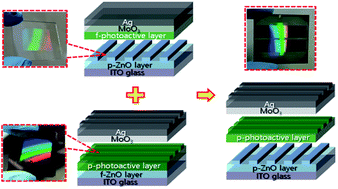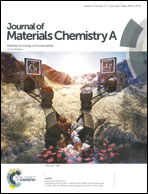Cumulative gain in organic solar cells by using multiple optical nanopatterns†
Abstract
Light wave manipulation by using nanostructures is a promising strategy for enhancing the light absorption of thin photoactive layers in organic photovoltaics (OPVs). Here, we propose a method for nanopatterning the multiple interfaces in bulk heterojunction (BHJ) OPVs by using soft imprint lithography at room temperature. The interfaces in the OPVs were separately modified in the front ZnO layers and the back metal electrodes with a grating pattern. Each nanopattern increased the light absorption and the power conversion efficiency of the OPVs by up to 32.5% depending on the materials. Moreover, the nanopatterning at both the front and the back cumulatively increased the light absorption, resulting in the highest efficiency increase of 38.5%. The increases were observed in various BHJ systems with different properties containing the polymers PTB7, PCE10, P3HT, or PNTz4T. A certified performance of 10.31% was achieved for the PNTz4T:PC71BM system in the presence of the nanopatterns. Detailed analysis by using the absorption spectra and optical simulations indicated that the origins of the optical gains from the nanopatterns on the front and the back are different. The front pattern increases the transmittance and the back pattern increases the scattering and excites the surface plasmon polaritons.



 Please wait while we load your content...
Please wait while we load your content...